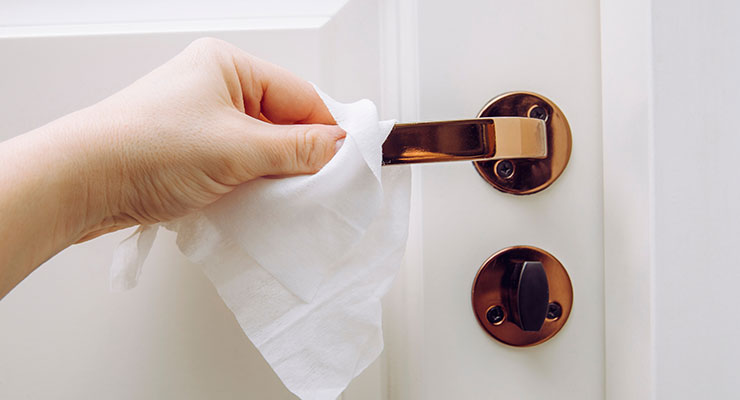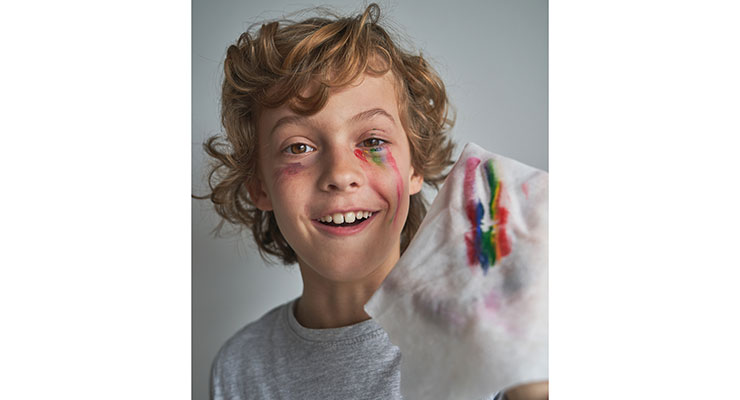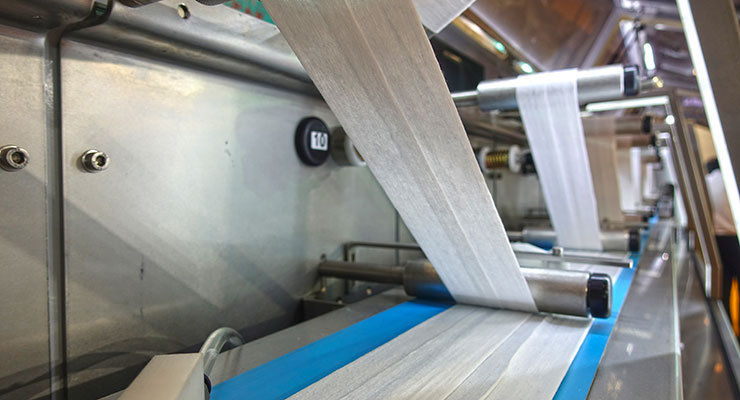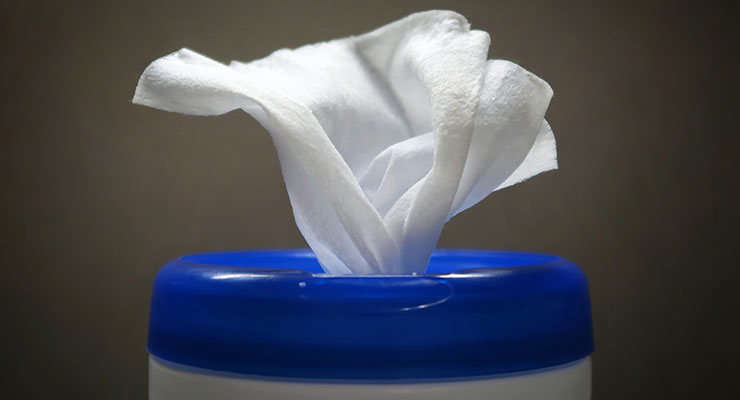Paolo Siragusa PhD, Noa Ziklo PhD, Naama Eylon, Sharon Personal Care03.30.23
There is a lot more to wipes than meets the eye. And the parts we cannot see are the most interesting aspects of wipes.
Formulation of wet wipes may seem like a relatively simple task. As our industry is striving to meet consumer demand for a clean and minimalistic ingredient list, it may not require the knowledge of a skin care product. After all, if we could create a wipe that is just fabric and water, wouldn’t that be ideal? We know the answer to that is - no, not really.
A wet wipe is expected to clean. If we are in need of a wipe for cleansing—dirt is a built-in part of the equation. While the wipe is expected to clean – remove dirt, remove make up, and more, it also needs to moisturize, so we need a formula to support both aspects.
In addition, we expect safety. Especially as personal care wipes refer to hygiene products, baby care, intimate care, and facial cleansers—sensitive areas. Safety starts in product integrity, which comes from antimicrobial protection and the right ingredient mix to avoid unwanted interactions and achieve stability. Safety continues with the right packaging. Wipe packs are re-sealable, and often opened with unwashed hands, bringing constant contamination risk into the product. The last step in safety is skin safety. From toxicological risk assessment to irritation testing.
To balance all those needs, you need to understand the delicate mechanism of wet wipes composition. Wet wipes consist of two parts; a nonwoven fabric carrier that is impregnated with an aqueous solution, known as the formula.
In addition, the supply chain is extremely wide, and information is sometimes highly specialized and sector-specific. With this in mind, the term "World of Wipes (WOW)" is more than justified and, for simplicity's sake, the WOW supply chain can be broken down into three basic points: the equipment, the fabric (nonwoven or otherwise), and the lotion.
The following three elements must work in harmony to obtain a quality product:
Products tailormade according to the relevant product type and claims provide an easy solution.
The products are supplied as ready-to-use concentration, and will be added to the water phase, with an additional preservative system and fragrance, if desired. For example, a smart concentrated wipes lotion formula emulsion for makeup remover wipes will be comprised of Water, C12-15 Alkyl Benzoate, Triisostearin, Diglycerin, Glyceryl Stearate, Caprylic/Capric Triglyceride, Cetyl Palmitate, Potassium Cetyl Phosphate, Caprylyl Glycol and Ethylhexylglycerin. For concentrate will be used at a level of 5%, and added to the water. As there is often a preference for high pH in makeup remover wipes, the formula should be complemented with a non-pH dependent preservation, such as a system comprised of Methylpropanediol, Caprylyl Glycol, Polyquaternium-80, Didecyldimonium Chloride. This system provides broad spectrum protection and is non-pH dependent, as well as “free-from” undesired ingredients, and tested for facial and ocular irritation.
To create a Micellar Wipes Lotion, to answer a need for “Detox” wipes mentioned above, a different concentration formula can be used, which contains: Caprylyl/Capryl Glucoside, Polyglyceryl-3 Cocoate, Polyglyceryl-10 Laurate, Citric Acid, water. This concentrate will be used at a level of 2.5% and added to the water. Here as well, it should be complemented with a relevant preservation system, and we will expand on some new alternatives shortly.
Avoiding microbial contamination and adequate preservation are keys to product safety. It is well known that wipes preservation is considered extremely challenging.
The combination of a liquid—which is the usual area of microbial growth—and a substrate, is a root cause of the challenge in wipes preservation. A standard concern by personal care product formulators is matching a preservative solution to a specific formulation, so that the product is not only protected from contamination, but also stable, and all components are compatible with each other. With wipes, further complications are expected, due to potential interactions between the liquid and the substrate, as well as the preservative and substrate.
Simultaneously, the same formula was tested again, this time with the presence of the nonwoven fabric. The challenge test results show a different story: The same preservative system, which was proven to protect the formula alone, is unable to provide the same protection for the formula once the nonwoven is introduced, leading to a failed result. Therefore, we can conclude it is indeed the presence of the nonwoven, which is raising the microbial risk. Another conclusion we can make is that a challenge test performed on the formula alone is not sufficient to establish proven antimicrobial protection, and this test must be done on the full product—fabric and formula together.
Biofilm is defined as a bacterial population composed by cells steadily adhering between them onto a solid surface, creating micro colonies. Biofilm is a polysaccharide coating, shielding the bacteria and promoting colonies adhesion on viscose fibers.
Biofilm formation is a concern to many manufacturers, not only personal care product manufacturers. This risk is associated with the production environment. Many cases of biofilm formation in production equipment pipes have been reported over the years – and not only pipes. The biofilm risks are clear – from corrosion and risk of the equipment integrity to microbial contamination of the products.
When it comes to wipes, the biofilm risk does not originate from the production equipment, it comes from within—from the product itself.
An in-depth study shows non-woven fabrics which have viscose fibers, are at risk of biofilm formation.1 The study was performed by introducing several strains of bacteria such as P. aeruginosa, S. aureus, E. coli and others, to different fabrics. We observed that bacteria have expanded into a biofilm, coating the viscose fibers completely. An example is shown in the biofilm formation of P. aeruginosa on viscose fibers.
Solving the biofilm problem was a key factor when developing a new preservation system for wipes.
The goal was to create a solution that will address and solve the challenges described above, but also to take into account the industry's requirements: It should be easy to incorporate in the wet-wipes’ production, answer the need for a clean label—and of course—be safe for facial and baby care.
Firstly, we address the antimicrobial part of the integrative solution, and the answer comes from the use of zinc lactate, which is a zinc salt derived from the natural component lactic acid and provides good antimicrobial efficacy. In literature, it is also described as delivering additional benefits, such as anti-inflammatory, antioxidant, and with potential efficacy towards anti-ageing, reduces skin sebum levels and supports moisturization. In wipes formulation, water is the main component. Therefore, high hydro solubility of the antimicrobial component is extremely important. Zinc lactate has excellent hydro solubility, making it an ideal solution for wipes. While zinc lactate shows good potential for antimicrobial protection, by itself it does not solve the full needs of wipes protection.
The second component to complete the task will work as the anti-biofilm agent. In the systems developed on the basis of this research, the selected component is Levulinic acid and its sodium salt (levulinate). Levulinic acid is described as a skin conditioning agent. It is natural and obtained from non-GMO sources. It has antimicrobial activity, but in this platform it is delivering the desired anti-biofilm protection needed.
An in-house experiment was done measuring Pseudomonas aeruginosa biofilm formation by quantifying the optical density of the culture following crystal violet staining. This method is a well-known tool to assess the anti-biofilm capacity of a compound. We tested the anti-biofilm efficacy of a preservative blend, with and without an anti-biofilm agent, which we have previously identified in our lab. The test results show that the antibiofilm agent used in the preservative system can address this risk entirely, resulting in a well-protected formula. This was further assessed by a challenge test, indicating better protection to the wet wipes, as a final product, preserved with the addition of the anti-biofilm. The successful results can be seen in reference 5.
Then we turn to consumer safety. A series of tests were conducted, including a single patch test for sensitive skin, clinical evaluation of the cutaneous acceptability, which is done for multi-daily facial applications, and ocular irritancy. These tests were chosen based on the understanding of real consumer usage habits. All tests’ results showed no irritation and, therefore, are suitable for such sensitive product application.
The unique and challenging industry of wet wipes calls for new solutions. Only as we go deeper into the science, the research and development work will deliver new innovation to match changing industry needs, and ultimately help us bring better, safer, products.
Formulation of wet wipes may seem like a relatively simple task. As our industry is striving to meet consumer demand for a clean and minimalistic ingredient list, it may not require the knowledge of a skin care product. After all, if we could create a wipe that is just fabric and water, wouldn’t that be ideal? We know the answer to that is - no, not really.
A wet wipe is expected to clean. If we are in need of a wipe for cleansing—dirt is a built-in part of the equation. While the wipe is expected to clean – remove dirt, remove make up, and more, it also needs to moisturize, so we need a formula to support both aspects.
In addition, we expect safety. Especially as personal care wipes refer to hygiene products, baby care, intimate care, and facial cleansers—sensitive areas. Safety starts in product integrity, which comes from antimicrobial protection and the right ingredient mix to avoid unwanted interactions and achieve stability. Safety continues with the right packaging. Wipe packs are re-sealable, and often opened with unwashed hands, bringing constant contamination risk into the product. The last step in safety is skin safety. From toxicological risk assessment to irritation testing.
To balance all those needs, you need to understand the delicate mechanism of wet wipes composition. Wet wipes consist of two parts; a nonwoven fabric carrier that is impregnated with an aqueous solution, known as the formula.
The Formulation Aspect
Wet wipes are commonly thought of as simple and essential products, but in reality, they involve a complex and highly specialized supply chain. In fact, the issues to focus on are many and not easily summarized.In addition, the supply chain is extremely wide, and information is sometimes highly specialized and sector-specific. With this in mind, the term "World of Wipes (WOW)" is more than justified and, for simplicity's sake, the WOW supply chain can be broken down into three basic points: the equipment, the fabric (nonwoven or otherwise), and the lotion.
The following three elements must work in harmony to obtain a quality product:
- Safety of use - Preservation
- Comfort of use - Mild and Sensoriality; and
- Effectiveness - Performance; Cleanse.
Products tailormade according to the relevant product type and claims provide an easy solution.
The products are supplied as ready-to-use concentration, and will be added to the water phase, with an additional preservative system and fragrance, if desired. For example, a smart concentrated wipes lotion formula emulsion for makeup remover wipes will be comprised of Water, C12-15 Alkyl Benzoate, Triisostearin, Diglycerin, Glyceryl Stearate, Caprylic/Capric Triglyceride, Cetyl Palmitate, Potassium Cetyl Phosphate, Caprylyl Glycol and Ethylhexylglycerin. For concentrate will be used at a level of 5%, and added to the water. As there is often a preference for high pH in makeup remover wipes, the formula should be complemented with a non-pH dependent preservation, such as a system comprised of Methylpropanediol, Caprylyl Glycol, Polyquaternium-80, Didecyldimonium Chloride. This system provides broad spectrum protection and is non-pH dependent, as well as “free-from” undesired ingredients, and tested for facial and ocular irritation.
To create a Micellar Wipes Lotion, to answer a need for “Detox” wipes mentioned above, a different concentration formula can be used, which contains: Caprylyl/Capryl Glucoside, Polyglyceryl-3 Cocoate, Polyglyceryl-10 Laurate, Citric Acid, water. This concentrate will be used at a level of 2.5% and added to the water. Here as well, it should be complemented with a relevant preservation system, and we will expand on some new alternatives shortly.
Diving Deeper into Product Safety
Ingredients and components used in personal care, facial and baby wipes should be addressed by means of antimicrobial protection, safety evaluation and clinical testing.Avoiding microbial contamination and adequate preservation are keys to product safety. It is well known that wipes preservation is considered extremely challenging.
The combination of a liquid—which is the usual area of microbial growth—and a substrate, is a root cause of the challenge in wipes preservation. A standard concern by personal care product formulators is matching a preservative solution to a specific formulation, so that the product is not only protected from contamination, but also stable, and all components are compatible with each other. With wipes, further complications are expected, due to potential interactions between the liquid and the substrate, as well as the preservative and substrate.
The Nonwovens Effect on Bacteria Growth
To establish a baseline, we are stating the introduction of the fabric is part of the microbial risk. To prove this, we went to a comparative challenge test, based on EP and USP protocol. In once case, we have a challenge test performed on a standard wipes formula, just the aqueous solution without any nonwoven fabric. The formula was preserved with a blend of organic acids. The challenge test results show that the preservative system provides full protection for the formula against gram negative and positive bacteria, yeast and mold.Simultaneously, the same formula was tested again, this time with the presence of the nonwoven fabric. The challenge test results show a different story: The same preservative system, which was proven to protect the formula alone, is unable to provide the same protection for the formula once the nonwoven is introduced, leading to a failed result. Therefore, we can conclude it is indeed the presence of the nonwoven, which is raising the microbial risk. Another conclusion we can make is that a challenge test performed on the formula alone is not sufficient to establish proven antimicrobial protection, and this test must be done on the full product—fabric and formula together.
Biofilm Formation
Only in recent years, we have started to deeply explore the impact of biofilm in wipes.Biofilm is defined as a bacterial population composed by cells steadily adhering between them onto a solid surface, creating micro colonies. Biofilm is a polysaccharide coating, shielding the bacteria and promoting colonies adhesion on viscose fibers.
Biofilm formation is a concern to many manufacturers, not only personal care product manufacturers. This risk is associated with the production environment. Many cases of biofilm formation in production equipment pipes have been reported over the years – and not only pipes. The biofilm risks are clear – from corrosion and risk of the equipment integrity to microbial contamination of the products.
When it comes to wipes, the biofilm risk does not originate from the production equipment, it comes from within—from the product itself.
An in-depth study shows non-woven fabrics which have viscose fibers, are at risk of biofilm formation.1 The study was performed by introducing several strains of bacteria such as P. aeruginosa, S. aureus, E. coli and others, to different fabrics. We observed that bacteria have expanded into a biofilm, coating the viscose fibers completely. An example is shown in the biofilm formation of P. aeruginosa on viscose fibers.
Solving the biofilm problem was a key factor when developing a new preservation system for wipes.
The goal was to create a solution that will address and solve the challenges described above, but also to take into account the industry's requirements: It should be easy to incorporate in the wet-wipes’ production, answer the need for a clean label—and of course—be safe for facial and baby care.
New Solutions in Wipes Preservation
The proposed platform shared here is an integrative solution that addresses all these aspects. Obviously, no one component can achieve such a task. Therefore, building a comprehensive, broad-spectrum solution will come from a careful selection of components that will work together.Firstly, we address the antimicrobial part of the integrative solution, and the answer comes from the use of zinc lactate, which is a zinc salt derived from the natural component lactic acid and provides good antimicrobial efficacy. In literature, it is also described as delivering additional benefits, such as anti-inflammatory, antioxidant, and with potential efficacy towards anti-ageing, reduces skin sebum levels and supports moisturization. In wipes formulation, water is the main component. Therefore, high hydro solubility of the antimicrobial component is extremely important. Zinc lactate has excellent hydro solubility, making it an ideal solution for wipes. While zinc lactate shows good potential for antimicrobial protection, by itself it does not solve the full needs of wipes protection.
The second component to complete the task will work as the anti-biofilm agent. In the systems developed on the basis of this research, the selected component is Levulinic acid and its sodium salt (levulinate). Levulinic acid is described as a skin conditioning agent. It is natural and obtained from non-GMO sources. It has antimicrobial activity, but in this platform it is delivering the desired anti-biofilm protection needed.
An in-house experiment was done measuring Pseudomonas aeruginosa biofilm formation by quantifying the optical density of the culture following crystal violet staining. This method is a well-known tool to assess the anti-biofilm capacity of a compound. We tested the anti-biofilm efficacy of a preservative blend, with and without an anti-biofilm agent, which we have previously identified in our lab. The test results show that the antibiofilm agent used in the preservative system can address this risk entirely, resulting in a well-protected formula. This was further assessed by a challenge test, indicating better protection to the wet wipes, as a final product, preserved with the addition of the anti-biofilm. The successful results can be seen in reference 5.
Then we turn to consumer safety. A series of tests were conducted, including a single patch test for sensitive skin, clinical evaluation of the cutaneous acceptability, which is done for multi-daily facial applications, and ocular irritancy. These tests were chosen based on the understanding of real consumer usage habits. All tests’ results showed no irritation and, therefore, are suitable for such sensitive product application.
The unique and challenging industry of wet wipes calls for new solutions. Only as we go deeper into the science, the research and development work will deliver new innovation to match changing industry needs, and ultimately help us bring better, safer, products.






